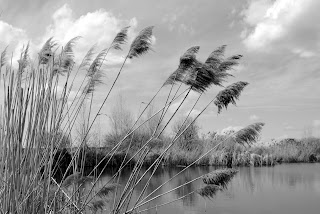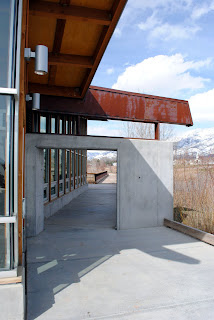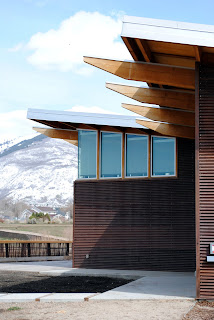
"Today less than 1% of Utah's total land is wetlands. Seventy-five percent of these remaining wetlands, approximately 400,000 acres, are part of the Greater Great Salt Lake Ecosystem. This wetland ecosystem is known internationally for its importance to migrating shorebirds and waterfowl, not to mention aquatic and terrestrial wildlife and other avian species on the move during seasonal migrations. The Greater Great Salt Lake Ecosystem encompasses the area from Cache Valley, down the Bear River, along the shore of the Great Salt Lake, up the Jordan River, around Utah Lake and up the Provo River to Jordanelle Reservoir. It includes freshwater wetlands, salt water wetlands, open water, mudflats, and everything in between to support an incredible diversity of flora and fauna.
In 1995, the Mitigation Commission funded a Needs Assessment and Conceptual Plan for Interpretive Recreation and Education for the Greater Great Salt Lake Wetlands Ecosystem to help raise public awareness of this resource. The report identified a gap between the level of importance the public placed on wetlands and wetlands awareness, and opportunities available to satisfy those needs. To facilitate an interpretive recreation and education master plan that identifies how to reduce that gap for the Greater Great Salt Lake Ecosystem wetlands, the Commission helped fund and participated in developing a wetlands education plan.
The Commission's partnership with the Utah Botanical Center includes Commission funded construction in 2005, 2006 and 2008 of portions of the Center's proposed wetlands education facilities. Moreover, the American Recovery and Reinvestment Act of 2009 provided the opportunity to complete installation of solar panels, a trail and boardwalks, and native vegetation at the Center's Wetlands Discovery Point. The Wetlands Discovery Point is a state-of-the-art classroom located adjacent to constructed wetlands. It received the Leadership in Energy and Environmental Design Platinum certification, the highest ranking awarded by the U.S. Green Building Council."
(http://www.mitigationcommission.gov/wetlands/wetlands_weep.html)


From ajc architects website:
"Built on the edge of a series of small ponds, elevated over the floodplain, the Wetland Discovery Point will facilitate interaction between the natural environment and primarily K-12 students. The Utah Botanical Center is committed to being an example of sustainable design to the State of Utah and its surrounding communities.
The facility is LEED Platinum Certified. Key sustainable features include geothermal heating and cooling, passive solar trombe wall, photovaltaics, solar hot water, trestlewood harvested from the Great Salt Lake, water collection rainwater harvesting caterer, operable windows designed for natural convection, waterless/low flow fixtures, highly reflective roof, large eaves for shading and sun control, and the boardwalk."
Project Recognition
2009 Intermountain Contractor, Best Sustainable Project, Merit Award
2009 AIA Utah Sustainable Design, Merit Award
2010 USGBC LEED Platinum


"This newly constructed 3,200 square-foot building, Wetland Discovery Point, is the third LEED Platinum certified structure in the state of Utah, making it one of the greenest buildings around. WDP is part of the Utah Botanical Center of Utah State University and provides an indoor / outdoor learning experience for over 4,000 school children each year.
* Butterfly roof for rainwater collection;
* Rainwater collection used for toilets/landscaping;
* Drought tolerant, native landscaping;
* Radiant floor heating and cooling;
* 30% more openings for natural ventilation;
* 10-ft high trombe wall to collect passive solar heat;
* Low-water use fixtures and plumbing;
* On-site solar panels for green power;
* Rooftop solar water heating for showers, sinks, radiant floor;
* 95% of the construction waste was recycled;
* Use of FSC-certified woods and low VOC products; and
* High recycled content materials used throughout.
Eventually, combining the passive solar design features, together with the solar thermal and solar panels, the Wetland Discovery Center intends to be net zero energy. It's a stunning, modern example of cutting-edge sustainable design."
(http://www.jetsongreen.com/2009/07/wetland-discovery-point-takes-leed-platinum.html)


"The building’s wing-like roof is visible from I-15 in Kaysville adjacent to the UBC ponds. It is the site of educational courses and field trips for adults and the thousands of school children who visit the center each year to learn about the importance of conservation and wetland ecosystems. “It isn’t often a client is willing to commit to the extra cost associated with achieving a LEED Platinum level of certification,” said Derek Wilson, ajc’s project architect. “It was a combined effort from a determined and committed owner to every engineer and subcontractor working on the project.” Although it is a public space, Wetland Discovery Point showcases green design details that can be used in homes as well. The roof functions as both a rainwater collector and a tool to provide shade or allow winter sunlight into the building to warm it and provide abundant natural light. Harvested precipitation is stored in a cistern and used to irrigate part of the landscape and to flush low flow toilets. Much of the power used in the building will be solar generated, and solar-heated water flows through the building’s heating system. Extensive use of windows connects visitors with the landscape and improves ventilation."
(http://utahbotanicalcenter.org/htm/innovation/demonstration/wdp/)


"Earning Platinum certification is an exciting step in our mission to demonstrate ways of living more sustainably,” said UBC Director David Anderson. “We constantly explore opportunities to teach people of all ages about the importance of good stewardship and this building reflects that goal. We are very appreciative of the support we received from the university, the design team, the contractor and our donors."
(http://utahbotanicalcenter.org/htm/innovation/demonstration/wdp/)
USU Wetland Discovery Point Building Highlights from Gary Neuenswander on Vimeo.
--All photos taken by blog post author in April 2010.




This comment has been removed by the author.
ReplyDeleteThanks for the info and facts. You offered meals for believed. Thanks for sharing the facts. Each and every with the most helpful to you. Solar panel cleaning Ipswich We use a strong telescoping soft brush that safely cleans the solar panels without applying pressure.
ReplyDeleteThis comment has been removed by the author.
ReplyDeleteThanks for sharing facts of solar dear. I found some information about commercial solar ppa & solar panel installation company. Read it. It's really informative stuff dear.
ReplyDelete